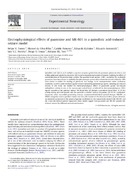Use este identificador para citar ou linkar para este item:
https://repositorio.ufrn.br/handle/1/6200Registro completo de metadados
| Campo DC | Valor | Idioma |
|---|---|---|
| dc.contributor.author | Torres, Felipe V. | - |
| dc.contributor.author | Silva Filho, Manoel da | - |
| dc.contributor.author | Antunes, Catiele | - |
| dc.contributor.author | Kalinine, Eduardo | - |
| dc.contributor.author | Antoniolli, Eduardo | - |
| dc.contributor.author | Portela, Luis V.C. | - |
| dc.contributor.author | Souza, Diogo O. | - |
| dc.contributor.author | Tort, Adriano Bretanha Lopes | - |
| dc.date.accessioned | 2013-02-25T12:39:06Z | - |
| dc.date.available | 2013-02-25T12:39:06Z | - |
| dc.date.issued | 2010 | - |
| dc.identifier.citation | TORRES, F ; FILHO, M.S. ; ANTUNES, C. ; KALININE, E. ; ANTONIOLLI, E. ; PORTELA, Luis Valmor ; SOUZA, Diogo Onofre ; TORT, A. B. L. ., (2010) | pt_BR |
| dc.identifier.uri | https://repositorio.ufrn.br/jspui/handle/1/6200 | - |
| dc.description | TORRES, F ; FILHO, M.S. ; ANTUNES, C. ; KALININE, E. ; ANTONIOLLI, E. ; PORTELA, Luis Valmor ; SOUZA, Diogo Onofre ; TORT, A. B. L. . Electrophysiological effects of guanosine and MK-801 in a quinolinic acid-induced seizure model. Experimental Neurology , v. 221, p. 296-306, 2010 | pt_BR |
| dc.description.abstract | Quinolinic acid (QA) is an N-methyl-D-aspartate receptor agonist that also promotes glutamate release and inhibits glutamate uptake by astrocytes. QA is used in experimental models of seizures studying the effects of overstimulation of the glutamatergic system. The guanine-based purines (GBPs), including the nucleoside guanosine, have been shown to modulate the glutamatergic system when administered extracellularly. GBPs were shown to inhibit the binding of glutamate and analogs, to be neuroprotective under excitotoxic conditions, as well as anticonvulsant against seizures induced by glutamatergic agents, including QA-induced seizure. In this work, we studied the electrophysiological effects of guanosine against QA-induced epileptiform activity in rats at the macroscopic cortical level, as inferred by electroencephalogram (EEG) signals recorded at the epidural surface. We found that QA disrupts a prominent basal theta (4–10 Hz) activity during peri-ictal periods and also promotes a relative increase in gamma (20–50 Hz) oscillations. Guanosine, when successfully preventing seizures, counteracted both these spectral changes. MK-801, an NMDA-antagonist used as positive control, was also able counteract the decrease in theta power; however, we observed an increase in the power of gamma oscillations in rats concurrently treated with MK-801 and QA. Given the distinct spectral signatures, these results suggest that guanosine and MK-801 prevent QAinduced seizures by different network mechanisms. | pt_BR |
| dc.language.iso | eng | pt_BR |
| dc.rights | Acesso Aberto | pt_BR |
| dc.subject | EEG | pt_BR |
| dc.subject | Seizure | pt_BR |
| dc.subject | Epilepsy | pt_BR |
| dc.subject | Theta | pt_BR |
| dc.subject | Gamma | pt_BR |
| dc.subject | Neuroprotection | pt_BR |
| dc.subject | AED | pt_BR |
| dc.title | Electrophysiological effects of guanosine and MK-801 in a quinolinic acid-induced seizure model | pt_BR |
| dc.type | article | pt_BR |
| Aparece nas coleções: | ICe - Artigos publicados em periódicos | |
Arquivos associados a este item:
| Arquivo | Descrição | Tamanho | Formato | |
|---|---|---|---|---|
| AdrianoBLTort_ICE_Electrophysiological2010.pdf | 2,1 MB | Adobe PDF |  Visualizar/Abrir |
Os itens no repositório estão protegidos por copyright, com todos os direitos reservados, salvo quando é indicado o contrário.

